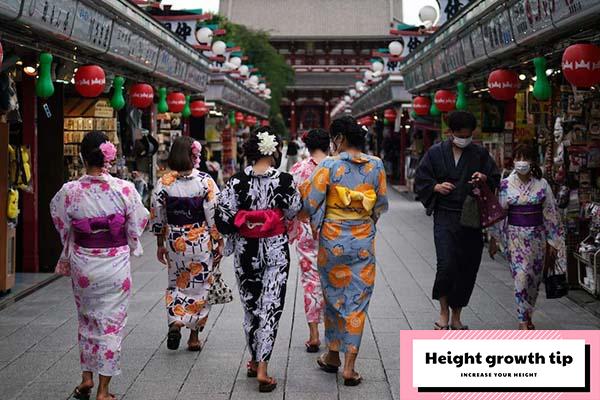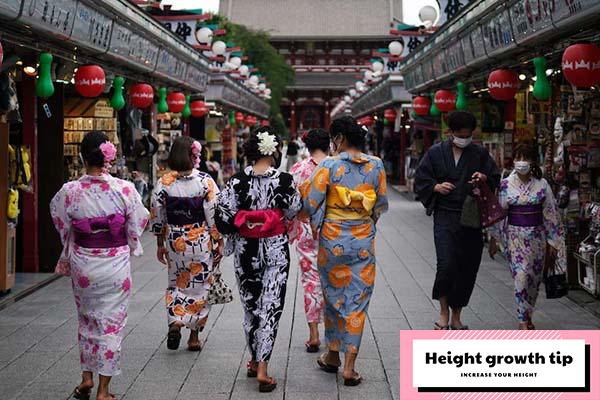Over the course of history, the Japanese have consistently shown shorter statures compared to their Western counterparts and individuals from Central Asian nations like Korea and China. However, the past century has seen notable shifts in the average height of the Japanese people.
The enduring fixation on height remains a captivating aspect of Japanese culture and continues to pique our collective curiosity.
Is it indeed a fact that the Japanese tend to be shorter in stature?
Historically, Japanese individuals have often been categorized as part of the shorter demographic when viewed on a global scale. In the past, the average height for Japanese men typically hovered around 5 feet 2 inches (160.3 cm), while Japanese women averaged approximately 4 feet 9 inches (148.9 cm) in height.
This relatively modest stature can be partially attributed to a specific genetic factor known as high mobility group AT-hook 2 (HMGA2), which has been observed to influence the skeletal structure of East Asians. However, it is essential to acknowledge that the perception of shorter height among the Japanese has persisted for over a century. The aftermath of World War II brought about significant changes in both the physical and psychological aspects of the Japanese population. This complex historical context has played a crucial role in perpetuating the enduring stereotype of shorter stature in Japan.

So, what about the average height in Japan and the world today?
Let’s delve into the fascinating topic of average height, both in Japan and globally, as it stands today.
Remarkably, Japan has undergone a remarkable transformation in terms of height over the years, experiencing the most substantial growth among all nations, with the exception of South Korea. From 1914 to 2014, the average height in Japan has surged by an impressive nearly 6 inches (equivalent to 15 centimeters). Presently, the average height for Japanese men measures at 5 feet 8 inches (approximately 172.06 centimeters), while Japanese women boast an average height of 5 feet 2 inches (or 158.5 cm).
However, when we compare these heights to those of individuals in countries such as the United States, Australia, or the United Kingdom, it becomes evident that Japanese people, on average, still tend to be approximately 1.1 to 1.5 inches (about 3 to 4 centimeters) shorter.
To provide a comprehensive view, here is a table illustrating the average heights across various countries:
| Country | Male average height | Female average height |
| Latvia | 5 feet 11 ½ inches (181.2 centimeters) | 5 feet 6 ½ inches (168.8 centimeters) |
| Dutch | 5 feet 11 ½ inches (181.2 centimeters) | 5 feet 6 ½ inches (168.5 centimeters) |
| Denmark | 5 feet 11 inches (180.4 centimeters) | 5 feet 6 inches (167.2 centimeters) |
| Poland | 5 feet 10 ½ inches (178.7 centimeters) | 5 feet 5 inches (165.1 centimeters) |
| German | 5 feet 10 inches (178 centimeters) | 5 feet 5 inches (165 centimeters) |
| Australia | 5 feet 9 inches (175.6 centimeters) | 5 feet 3 ½ inches (161.8 centimeters) |
| United States of America | 5 feet 9 inches (175.3 centimeters) | 5 feet 3 ½ inches (161.3 centimeters) |
| Spanish | 5 feet 8 ½ inches (174 centimeters) | 5 feet 4 inches (163 centimeters) |
| South Korea | 5 feet 8 ½ inches (174.6 centimeters) | 5 feet 3 ½ inches (161.5 cm) |
| China | 5 feet 6 inches (167.1 centimeters) | 5 feet 1 ½ inches (155.8 centimeters) |
| Thailand | 5 feet 4 ½ inches (163.7 cm) | 5 feet ½ inch (153.7 cm) |
| peruvian | 5 feet 4 ½ inches (164 centimeters) | 4 feet 11 ½ inches (151 centimeters) |
What are the key determinants influencing height in Japan?
Over the course of the last century, the average height of Japanese individuals, historically shorter compared to most Westerners, has exhibited noteworthy growth. This height evolution can be attributed to a multifaceted interplay of various factors:
Genetic Factors:
Genetics assume a pivotal role in shaping an individual’s stature. When parents are taller, there is a heightened likelihood that their offspring will inherit a taller stature as well. Following World War II, the presence of U.S. soldiers in Japan led to the birth of many mixed-race children, potentially influencing the height trajectory of future generations through genetic diversity.
Nutritional Influences:
A crucial determinant in fostering height development is adequate nutrition. The Japanese populace has made concerted efforts to enhance dietary and nutritional practices, with initiatives like the “Milk Plan” campaign initiated by the government during the 1950s and 1960s. This campaign aimed to bolster public health in the post-war period. By incorporating milk into school meals, the government sought to improve overall nutrition. Even today, Japanese students continue to consume dairy products. Nonetheless, their milk consumption tends to be lower in comparison to their American and European counterparts. Additionally, the inclusion of protein-rich foods such as pork and beef in their diets has contributed to increased protein intake, which plays a pivotal role in both muscle and bone growth.
The consumption of fish and natto (fermented soybeans) is prevalent in the Japanese diet, as these foods provide essential nutrients required for height growth and bone health.
While some households have transitioned from traditional Japanese breakfast fare like rice, seaweed, and soybean paste soup to more Westernized options such as toast, eggs, cereal, and salad, many hotels in Japan continue to offer a choice between Japanese and Western breakfasts. On the whole, when the Japanese diet is thoughtfully balanced, it serves as a reliable source of nutrients for fostering height growth.
These factors, when considered alongside improvements in healthcare and living conditions, have collectively contributed to the discernible increase in height among the Japanese population over the years.

Changes in Eating Habits:
The dietary preferences of the Japanese have undergone a profound transformation in the wake of rapid Westernization. In lieu of traditional rice-based lunches, many individuals now gravitate towards fast food or convenience store meals. Delivery services have expanded their offerings to include not only traditional rice and noodle dishes but also Western staples like pizza and hamburgers. These shifts in dietary habits hold the potential to exert a substantial impact on overall nutrition and health, potentially affecting growth patterns, including height development. Therefore, it remains crucial to uphold a balanced and nutritionally sound diet to ensure proper growth and overall development.
The Growth of the Dietary Supplement Industry:
The dietary supplement industry in Japan has experienced remarkable growth in recent years. Despite its relatively brief history and limited recognition until the early 1990s, Japan has now emerged as the third-largest market for dietary supplements on a global scale. Nearly 70% of the Japanese populace integrates vitamins and supplements into their daily routines, signifying an escalating awareness of the pivotal role proper nutrition and supplements can play in enhancing overall health and well-being.
The Role of Physical Activity:
In addition to maintaining a nutritious diet, regular physical activity can stimulate the release of growth hormones essential for height augmentation. In 1982, the Japanese government introduced the Radio Taiso radio exercise program, which has gained popularity among children and the elderly alike. Furthermore, Japanese children are actively encouraged to participate in a diverse array of sports from a tender age. These initiatives aimed at promoting physical activity likely contribute to the overarching increase in height observed among the Japanese population over the past century.
Evolving Lifestyles:
Traditionally, Japanese people sat on straw mats for centuries. However, under the influence of Western culture, they have adopted a more Western-style seating arrangement involving chairs or lying on beds. Over time, this transition has alleviated the consistent pressure on the knees of Japanese children, a factor that may have played a role in their heightened stature.
It is essential to recognize that while these factors can exert some influence on height, genetics and various other factors also wield significant sway in determining an individual’s ultimate height.
Conclusion
In conclusion, a comprehensive analysis of the past century reveals a significant increase in the average height of both Japanese men and women. Although Japanese individuals still tend to be shorter on average compared to their Western counterparts, there has been remarkable progress in height improvement. These improvements can be attributed to a complex interplay of factors, including improved nutritional standards, increased physical activity levels, and changing lifestyle patterns within Japanese society. However, it’s crucial to acknowledge that an individual’s height is the result of a intricate combination of genetic predispositions and environmental influences.
FAQs
How does the average height in Japan compare to the world?
Compared to the average height in other countries, Japanese individuals tend to be shorter. However, it is important to note that height can vary across different regions and populations within a country.
Why are Japanese people shorter on average?
The average shorter stature of Japanese individuals can be influenced by a combination of factors, including genetics, lifestyle, nutrition, and historical factors. Genetic factors, such as the presence of the high mobility group AT-hook 2 (HMGA2) gene, can affect skeletal structure and contribute to a shorter height.
Has the average height in Japan changed over time?
Yes, the average height in Japan has increased significantly over the last century. Factors such as improved nutrition, healthcare, and living conditions have contributed to this growth.
How does the average height in Japan compare to Western countries?
On average, Japanese individuals tend to be shorter compared to individuals in Western countries, such as the United States, Australia, or the United Kingdom. However, it’s important to remember that height can vary among individuals within any population.
Is height solely determined by genetics?
No, height is influenced by a combination of genetic and environmental factors. While genetics play a significant role, factors like nutrition, lifestyle, and overall health can also impact an individual’s height.
Can an individual’s height be changed after reaching adulthood?
Once an individual reaches adulthood, the potential for significant height increase diminishes as the growth plates in the bones close. However, maintaining good posture and overall health can contribute to appearing taller and maximizing one’s height potential.

